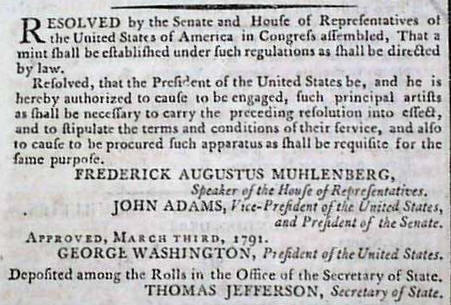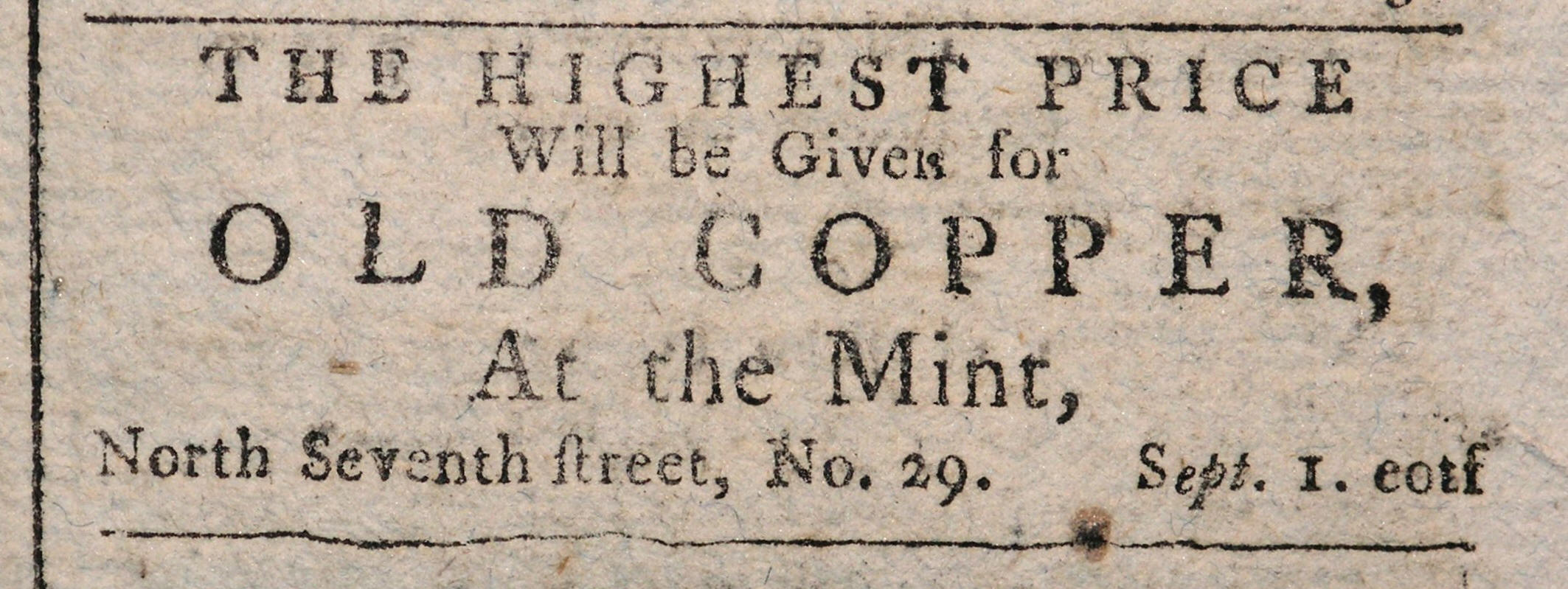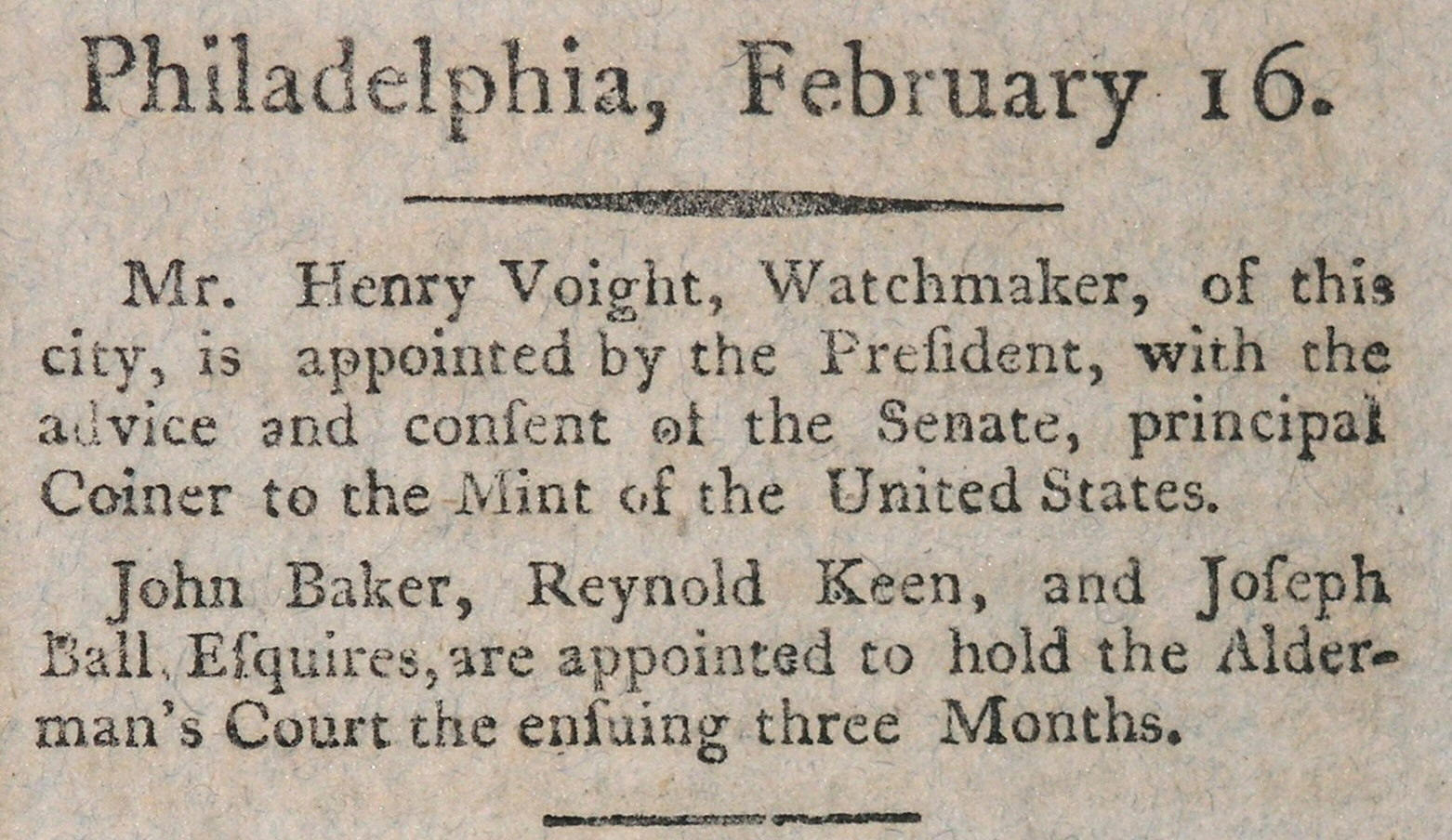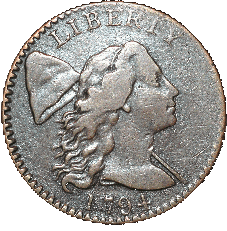|
About the Coins, the Exhibit & the Book |
|
NOSTALGIA OF THE LIBERTY CAP 1794 CENT "Considered as a whole, the Liberty Cap cents possess a charm not often exceeded among the things made by man. To no small degree the charm inheres in the great variability and individuality of these dies, of which there are no less than 105 – 53 obverses and 52 reverses (in 1794, 39 obverses and 38 reverses). About three fourths of the Liberty Caps are dated 1794, and among these nearly all of the variation occurs, since the first of the 1794’s are practically duplicates of the 1793’s, and the last of them are virtually duplicates of the 1795’s and 1796’s. A collection of 1794 cents reflects much of the story of one of the most pioneering and romantic struggles in American history. In the little Mint building on Seventh Street in Philadelphia, during the middle of the last decade of the eighteenth century, history seems almost to have held her breath for a time, and we find the marks of her desperately clenched teeth engraved deeply on the soft copper pennies of those years." (Dr. William H. Sheldon-1949) "Over the first 100 years of coin collecting in this country, the objectives of completeness, quality and historicity have been well explored. Collectors have been there and done that. Beginning about 25 years ago, a new collecting objective was defined. The new theory was that a coin’s past ownership – its provenance – was a pertinent variable. Whereas most catalogers had tended to ignore information concerning antecedents, a new breed of collectors came to appreciate that there could be spiritual bonds between the past and the present. If a coin had been owned by illustrious collectors in the past, then its present owner became a link in a chain of trusteeship that was at once both a responsibility and an honor. To own a large cent that had been owned by Maris or Hays or Clapp was to discover the dimension of time itself. Concerns regarding condition or completeness paled into relative insignificance." (John W. Adams – 2004) --------------------------------------------------------------------------------------- Arguably the most studied, written about and interesting of all US coins are the copper Large Cents produced between 1793 and 1857. Of these those of 1794 have motivated the most passionate of collectors. The 1794 large cents have the most traceable of pedigree chains; many of their images can be found in sales catalogs back to the 19th century. This web site evolved as an offshoot of an exhibit at the 2004 Early American Coppers Club convention in San Diego which featured all 58 collectible varieties of 1794 Large Cents. The exhibit coins were chosen based on their interesting pedigrees rather than their grade condition - lineages extending to Mickley, Maris, Frossard, Hays, Zug, Prosky, Hines, Gilbert, Steigerwalt, Clapp, and many other noted collectors of the distant, and not-so-distant, past. In the early years following the American Revolution the various mediums for commercial dealings consisted of world and colonial currencies, produce, fowl, livestock, alcohol, wampum plus assorted coins of Spanish, English, French, German, Dutch and Portuguese origins as well as various other issues. Along the Atlantic seaboard, bills of exchange, commercial transactions, and other obligations were usually expressed in Spanish milled dollars or British pounds sterling, both of which were composed of fractional components. Matters of finance and monetary policy had always been central to the Continental Congress. A committee on monetary policy was formed as early as April 19, 1776, and charged with examining and verifying the value of silver and gold coins then circulating in the colonies. The first effort of the committee was submitted on May 22 but was put aside. On July 24, just two weeks after composing the Declaration of Independence, Thomas Jefferson was appointed to the committee. On September 2, 1776, Jefferson submitted the committee's final report which included a chart listing the primary silver and gold coins in circulation with their equivalent values in relation to the Spanish American silver dollar. Interestingly, rather than use fractions, Jefferson was the first to use decimal notation to express these equivalent monetary values. About six months later, on February 20, 1777, another congressional committee concerned with matters pertaining to the treasury recommended a mint be established for the coining of money, but no further steps were taken on their recommendation. As the war continued, metal was recycled to produce canon, rifles, bullets as well as other equipment needed for military operations. Small denomination paper currency replaced much of the coinage. The Bank of North America was chartered by the Congress in 1781. This first commercial bank opened for business on January 7, 1782, in Philadelphia. Organized under a plan developed by Superintendent of Finance Robert Morris, the bank was established primarily to provide financing for the expenses of the American War of Independence. On January 15, 1782, Morris recommended establishment of a national mint and the adoption of a decimal coinage system. The following year Morris commissioned Benjamin Dudley, a British die engraver living in Boston, to prepare dies. Dudley was paid $72 on May 5, 1783 for “sinking, case hardening, &c. four Pair of Dies for Public Mint.” On April 2, 1783 Dudley presented the first sample Nova Constellatio silver pattern bearing a denomination of 1,000 units (mark.) Other denominations of 500 units (quint), 100 units (bit) and 5 units were later designed and struck. Despite intense efforts an actual mint failed to materialize, and the pieces produced remained as patterns with no regular-issue counterparts being produced. On July 6, 1785, Congress approved the dollar as the basic Currency unit with decimal subdivisions. However, no action was taken to establish a mint. On April 15, 1790, Congress instructed Secretary of the Treasury Alexander Hamilton to draft plans for the establishment of a national mint. On January 28, 1791, Hamilton submitted his Report on the Mint for consideration by Congress. In it he encouraged the use of coinage as part of his vision of developing a market economy. Contemporary commercial exchange, among commoners, still relied in large degree upon bartering. Copper cents and half cents were intended to benefit those of lesser means by enabling them to purchase goods in smaller quantities. On March 3, 1791, President George Washington approved the joint resolution of Congress which established the Mint. However, Hamilton regretted that the Mint was lodged under the jurisdiction of the Department of State; apparently as a concession to Secretary Jefferson’s interest in coinage. While serving as the United States minister in Paris, Jefferson had visited the royal mint and was intrigued by a coinage press, developed by Jean Pierre Droz, which impressed both obverse and reverse designs simultaneously.
The Act of April 2, 1792, legislation supplementary to the 1790 and 1791 efforts, addressed the establishment of a mint and the regulation of coinage of the United States. Section Nine determined the metals and denominations of the coins to be struck. This act still remains the basic one of our national coinage. It provided for the free coinage of gold and silver. In other words, anyone having gold and silver could take it to the Mint and have it coined free of expense. Most pertinent to the present text were the rules regarding copper: Cents – each to be the value of one-hundredths part of a dollar, and to contain 11 penny-weights of copper. The act of May 8, 1792 further provided for a copper coinage. Section One stated: "That the Director of the Mint, with the approbation of the President of the United States be authorized to contract for and purchase a quantity of copper, not exceeding one hundred and fifty tons, and that said Director, as soon as the needful preparation shall be made, cause the copper by him purchased to be coined at the Mint into cents and half cents…thence to issue into circulation." Section Two of the act stated that “no copper coins, or pieces whatsoever, except the said cents and half cents, shall pass current as money,” making the copper coinage produced at the Mint the only copper legal tender. Despite this intention, a flood of non-mint copper coins continued in circulation for many years thereafter; such pieces consisting of British halfpennies, “bungtown” coppers, imitation Irish and British halfpennies, coins issued by Massachusetts, New Jersey, Vermont, Connecticut, and many other styles, types, and varieties. The last section of the act of 1792 was the sole cause for changing all of the accounts of the public offices and all proceedings in the courts of the United States from the basis of pounds, shillings and pence to the decimal system of money that we use today. With the adoption of the decimal system and establishment of the first Mint of the United States we reached fruition of the efforts of three greats in American history, namely: Robert Morris, Alexander Hamilton and Thomas Jefferson, who had worked towards this objective for ten years or more. The aforementioned acts of April 2, 1792 and May 8, 1792 gave supreme authority and control of the Mint to the President. In six of his eight annual addresses to Congress he spoke of either the Mint or the currency. During his entire presidency of eight years he kept in close touch with the operations at the Mint; his residence but a short walk away. The acts also authorized President Washington to provide suitable buildings for the use of the Mint. In 1792, the prominent cultural and business centers of America included Baltimore, New York, Boston and Philadelphia. A decision was made to establish the Mint in Philadelphia which was, at the time, the interim Capital of the United States. "Philadelphia may be considered as the metropolis of the United States. It is certainly the finest town, and the best built; it is the most wealthy, though not the most luxurious. You will find here more men of information, more political and literary knowledge, and more learned societies. Many towns in America are more ancient; but Philadelphia has surpassed her elders…" Jacques Pierre Brissot de Warville New Travels in the United States of America 1792-1793
On April 14, 1792, President Washington appointed David Rittenhouse, the foremost scientist of the United States, as the first director of the Mint with an annual salary of $2,000. Rittenhouse was then in feeble health and lived at the north-west corner of Seventh and Arch Streets, then one of the better locations in Old Philadelphia, where he had an observatory and also where he died in 1796. Rittenhouse recommended to President Washington that a lot on the north-east corner of Seventh Street and Sugar Alley, on which stood an old distillery belonging to Michael Shubert, be purchased for the use of the Mint. He also recommended that copper metal be procured and that Henry Voight be secured as chief coiner. The Mint site was but a short distance from the residence of President Washington who lived less than 1000 feet away on the south side of Market Street between Sixth and Seventh Streets. It was less than 400 feet from Rittenhouse’s residence. This convenient location was no doubt influential in making the site selection. President George Washington wrote back to Director of the Mint David Rittenhouse, on July 9, 1792: "Having had under consideration the letter of the Director of the Mint for this day’s date, I hereby declare my approbation of the purchase he has made of the house and lot for the Mint, of the employment of Mr. Voight as coiner; of the procuring fifteen tons of Copper and proceeding to coin the Cents and Half Cents of Copper…" The property was paid for and deeded to the United States of America for a consideration of $4,266.67 appropriated by Congress on July 18, 1792. This appropriation was the first ever for a building to be used for governmental purposes The first of the Mint buildings was completed on September 7, 1792, and employees of the Mint commenced work there in the latter part of the month. In November, 1792, the following advertisement appeared in Philadelphia newspapers soliciting copper for the first coins to be produced: our Large Cents.
On February 16, 1793, George Washington appointed Henry Voight Principal Coiner to the Mint of the United States.
Large Cents are divided into three general types: Early Dates [1793-1814], Middle Dates [1816-1840] and Late Dates [1840-1857]. While there are many aficionados of each of these groupings it is considered that the most challenging are also the most ancient and those produced under the most primitive conditions; the Early Dates. The Early Dates are further divided into five sub-groupings: Flowing Hair (Chain), Flowing Hair (Wreath), Liberty Cap, Draped Bust and Classic (Turban Head). Of these sub-groups the Liberty Cap (1793-1796) cents are generally regarded as the most beautiful design and are often reverently collected and cherished. Of the Liberty Cap design; the 58 collectible varieties of the year 1794 may provide the foundation for a lifetime of study. The Liberty Cap large cents of 1793-1796 are surely the "classics" of early American copper coinage. They represent the third attempt of the infant Philadelphia Mint's quest for an acceptable cent design; succeeding those of the earlier Chain and Wreath designs which inaugurated this United States series in 1793. The Liberty Cap design was created by Joseph Wright, a Bordentown, New Jersey native and portraitist whose most famous works were his 1783 paintings of George and Martha Washington. Wright began work at the Mint, in August 1793, as an engraver and die-sinker under the renowned scientist and Mint Director David Rittenhouse. A catastrophic yellow fever epidemic broke out in Philadelphia shortly after Wright began work. No one knew the cause of this "mysterious" malady which was to claim more than 4,000 lives that summer. [It wasn't until 1900 that Maj. Walter Reed determined that yellow fever was spread by mosquitoes] Joseph Wright contracted the fever and died on September 13, after creating a legacy in what many consider to be the most beautiful US coin design; the Liberty Cap cents S-12 through S-20. Wright most likely died without having seen any of his coins struck. For his Liberty Cap cent Wright drew inspiration from a popular theme dating back to Roman times; that of the Liberty or Phrygian (pileus in Latin) cap. Wright is believed to have designed the obverse of the 1783 Libertas Americana medal {see the images section of this web site] which was minted in Paris. This famous medal depicted a lovely Lady Liberty facing left, her hair unbound and flowing in the wind. She carried a pole, topped by a pileus, over her shoulder. The Libertas Americana medal commemorated the American victories at Saratoga and Yorktown and was a private project of Benjamin Franklin. The medal was distributed to many VIPs on both continents. It served its purpose well as a symbol of French support for the American revolutionary cause. No other U.S. coins have attracted such intense study as the Liberty Cap cents. The evolution of large cent research appears to have began with Sylvester S. Crosby and J.N.T. Levick who, in April 1869, published the first treatise on the cents of 1793 which appeared in The American Journal of Numismatics . Also in 1869 Dr. Edward Maris, a Quaker doctor from Philadelphia, published a pamphlet identifying and naming 39 varieties of 1794 cents. Both 19th century dealer Samuel Hudson Chapman and 20th century cataloguer Dr. William H. Sheldon agreed that serious collectors would eventually "gravitate to early copper" and that, once there, many would end up "specializing in the date 1794," Copper cents were still a novelty when Wright created his dies. Most Americans had not yet seen any of the new Federal coinage, still limited to cents and half cents. The citizens of the growing nation, only in its sixth year under the Constitution, thought in terms of Spanish milled dollars, state copper coins and private tokens (when they thought of coins at all). So it was most important that the public accept the new cent, particularly considering the harsh reviews given Chain cent design when it was first released. This criticism may have been on Wright's mind as he began his work. Wright turned Liberty to the right and replaced the beehive-like pileus with a soft Phrygian cap worn in ancient times by newly freed slaves to signify their liberation. The reverse presented a sparser laurel wreath than the preceding coinage, bearing single berries on individual stems. The first Wright coins were in higher relief than later designs, their obverses shifting from beaded to denticled borders. Their edges bore the incuse inscription ONE HUNDRED FOR A DOLLAR, ending in a leaf. After Wright's death the
Liberty Cap design was modified by engraver Robert Scot who was
engaged for
the Mint by Director Rittenhouse. The Scot varieties of S-21 through S-66 display a much lower relief.
Later, Scot's design was replaced by that of another yet engraver, John
Smith Gardner, hired in November of 1794 and responsible for varieties
S-67 through S-72. Sheldon's 1795
listing includes the controversial "Jefferson Head" cent with an unusual
square-browed Liberty and pincer-like "crab claw" leaves in the wreath.
Considering the ongoing efforts of some in Congress to replace the Mint with
private contractors, many numismatists believe that these rare coins were
privately struck as patterns for a coinage contract sought by Philadelphia
saw-maker John Harper. Another unusual variety is the Missing
Fraction Bar (S-64), which omits the line between 1 and 100 in the fraction. Most
researchers attribute the dies used between December 1794 and April 1796 to Gardner, a general technician pressed into service to help meet demand for
cents of the new thin-planchet type. Coins of May to June 1796 were struck from
dies once again cut by Scot. In mid-1796, the Liberty Cap design was replaced by
Scot's interpretation of Gilbert Stuart's Draped Bust motif.
|
|
|



